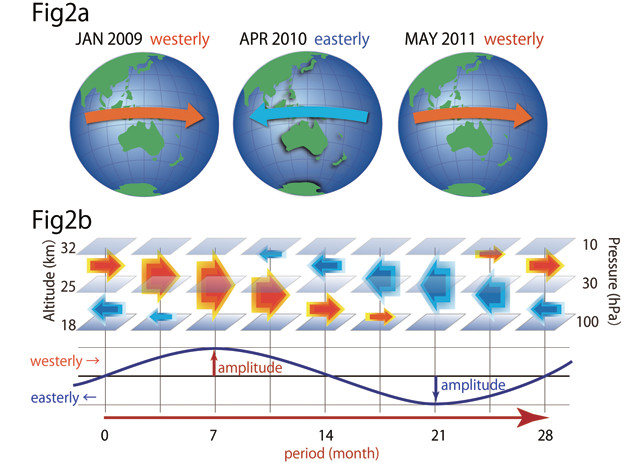
by Kate S. Zalzal Tuesday, December 27, 2016

The highly regular, quasi-biennial oscillation shifted unexpectedly in early 2016. Winds ordinarily flowing westward started flowing eastward, and moved lower in the atmosphere. Credit: ©JAMSTEC.
In early 2016, scientists first noticed an unexpected change in wind direction in the stratosphere some 25 kilometers above the equator. This shift signaled the beginning of a multimonth disruption of one of the most regular atmospheric phenomena known — the quasi-biennial oscillation (QBO). The disruption is the first such event observed in this system since record keeping began in the 1950s.
The QBO is the biggest jet stream on the planet, featuring regularly alternating eastward and westward winds that descend through the equatorial stratosphere from about 50 kilometers above Earth’s surface to about 16 kilometers. The system is driven by the action of atmospheric waves generated by storms and rainfall in the tropics that rise and encounter stratospheric waves. As monitored by balloon observations across equatorial regions, the periodicity of the QBO varies between 22 and 36 months and is highly predictable.
The wind shifts are “like the pendulum on a grandfather clock,” says Scott Osprey, an atmospheric scientist at the University of Oxford in England and lead author of the new study published in Science reporting the QBO disruption. The QBO is historically so regular in behavior that it’s often described as “nature’s heartbeat,” he says.
Osprey was first notified in March 2016 that something unusual was happening within the QBO by Adam Scaife, a colleague at the U.K. Met Office and co-author of the study, who noticed a change in a January stratospheric wind profile. “We kept an eye on it and, after a few weeks, it was quite apparent that something bizarre was going on,” Osprey says. Balloon measurements across the tropics showing similar behavior confirmed their suspicion that this was a systemwide event.
The disruption materialized as a strong, thin westward wind jet that suddenly appeared in the strongest part of the eastward jet. By March, this westward jet had strengthened and begun to descend. Using high-resolution meteorological data and computer models, Osprey and his colleagues pieced together the details of the event. “The QBO is maintained by [atmospheric] waves bubbling up from the equatorial troposphere. But in this event, we saw large waves arching up from the mid-latitudes and breaking around 25 kilometers up, over the equator,” Osprey says.
“Normally the higher latitude waves don’t reach into the tropics,” says Mark Baldwin, an atmospheric scientist at the University of Exeter in England who was not involved in the work. Although it’s unknown what drove these waves of unprecedented magnitude into the tropics, Osprey points to several recent anomalous events that coincided with the QBO shift — including a strong El Niño, sudden stratospheric warming, and warm sea-surface temperatures in the North Pacific Ocean — as possible factors causing the disruption in circulation.
The QBO is a tropical phenomenon, but it affects stratospheric flow from pole to pole by modulating the effects of extratropical waves, Baldwin says. “It’s important because it is one of the few tools for longer-range forecasting, six months or more out.” Along with other climate indices, the QBO is used in seasonal forecasts of Northern Hemisphere winter conditions, particularly those involving storm tracks influenced by the North Atlantic Oscillation.
As a consequence of the QBO disruption, forecasters now expect eastward winds in the lower stratosphere this winter rather than westward winds. “This means that the seasonal weather dice in the North Atlantic are now loaded toward [favoring] the storm systems that move up over the U.K. and into Scandinavia. We anticipate more rain in Northern Europe this winter,” Osprey says.
In light of the unprecedented disruption, scientists are now wondering how increasing temperatures will impact the QBO. “Under climate change, we expect wave-driven circulation to strengthen,” Osprey says. “The hypothesized effect of that would be to produce a more vulnerable stratosphere, so that these types of disruptions may be more frequent.” Both he and Baldwin point to the need for more modeling studies, focused on stratosphere-troposphere interactions, to better understand the atmospheric dynamics involved.
For now, the disrupted pattern looks to be on the wane, descending down through the stratosphere in its usual fashion. Over the next few months the QBO is expected to return to normal. “But this is still a breaking event,” Osprey says. “I think we’ll see a lot of research activity over the next few months [aimed at] getting to the bottom of this. Whatever happened to the QBO was very unexpected.”
© 2008-2021. All rights reserved. Any copying, redistribution or retransmission of any of the contents of this service without the expressed written permission of the American Geosciences Institute is expressly prohibited. Click here for all copyright requests.